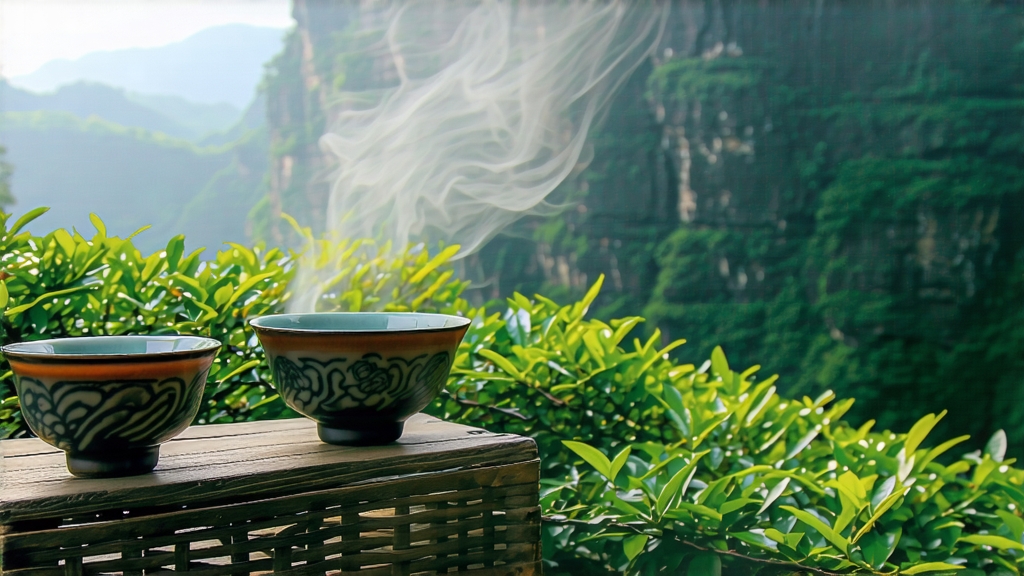
High in the crimson Danxia peaks of northern Fujian, where narrow gorges exhale perpetual mist and waterfalls drum on granite boulders, the tea gardens of Wuyi Shui Xian cling to crevices so steep that pickers once tied themselves to iron chains. Shui Xian—literally “water sprite” or “narcissus” in English—owes its lyrical name to a 12th-century legend: a traveling scholar, parched and feverish, dreamed of a celestial maiden who offered a cup of nectar drawn from an underground spring; upon waking he found a tea seedling rooted in the moist stone, its leaves exuding the same floral sweetness. Whether myth or marketing, the story captures the cultivar’s defining trait: an almost aqueous fragrance that lingers like mountain spring water infused with narcissus petals.
Historical records first name Shui Xian during the late Song dynasty, but its ascendancy begins in the Qing, when Wuyi monks selected the large-leaf, late-sprouting strain for its ability to absorb the mineral bite of volcanic rock. By the 1820s the cultivar had migrated downhill to the lowland county of Jianyang, where farmers planted it in fertile paddy soils and shipped the bulky leaves to Wuyi for finishing. These “immigrant” teas, sold under the umbrella term “Wuyi Narcissus,” helped satisfy booming European demand, yet connoisseurs soon noticed that only leaves grown inside the 60 km² core scenic zone—yan zheng di, the true “rock field”—delivered the elusive yan yun, or rock rhyme, a tactile echo of wet stone and cold mist that arrives minutes after swallowing. Today the Chinese government protects this micro-terroir with a geographic-indication seal; pickings from outside the heritage corridor must legally label themselves “Fujian Shui Xian,” a distinction that can halve the price.
Shui Xian belongs to the Si Da Ming Cong, the “four famous bushes” of Wuyi, alongside Da Hong Pao, Tie Luo Han, and Bai Ji Guan, yet it is the only one still cultivated extensively as a single-varietal rather than a proprietary blend. Garden managers prize the tree for its erect canopy, drought-resistant taproot, and leaves the size of a sparrow’s wing—traits that allow it to mine nutrients from fissures only a few centimeters deep. The traditional “short-cut” pruning style, renewed every three years, forces the plant to re-sprout from gnarled knobs that resemble dragon knuckles; locals call these lao cong, “old bushes,” and specimens over thirty years of age can fetch prices rivaling top-grade Da Hong Pao. A single 200-year-old mother tree still survives in the “Ghost Cave” ravine, its bark polished smooth by the palms of pilgrims seeking cuttings.
Making Shui Xian is a choreography of fire, moisture, and time that stretches across twenty-four hours. Picking begins at dawn when the sun burns off dew yet before the gorge winds desiccate the leaf; two leaves and a bud are snapped with a downward tug that audibly clicks the petiole. The harvest is carried in bamboo creels lined with banana leaves to prevent compression bruises, then withered on bamboo racks set inside a cliff-side cave whose mouth funnels cool, mineral-laden air. Once the leaf loses about 10 % of its weight and emits a faint baked-apple perfume, it is bruised by repeatedly tossing it into a rattan tray—an action that ruptures cells without macerating the edges, allowing partial oxidation that hovers between the 30 % of green oolong and the 70 % of black tea. The critical charcoal roasting follows, a Wuyi signature that differentiates Shui Xian from its southern cousin, Fenghuang Dancong. Using only the embers of local hardwoods—litchi, longan, and the resinous Chinese chestnut—roasters bury the tea in shallow bamboo sieves stacked inside a squat clay oven. Over six to eight hours the leaf is turned every twenty minutes while the master gauges temperature by pressing his forearm against the oven wall; too hot and the narcissus aroma collapses into charcoal, too cool and the grassy edge refuses to mellow. The process is repeated two more times at monthly intervals, each cycle deepening the amber color and layering notes of